|
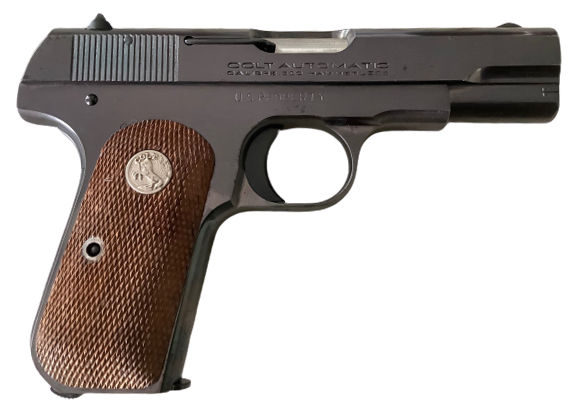
Private Collection
Colt Model 1908 Pocket Hammerless .380 ACP serial number
M137878
issued to Brigadier General Haskell E. Neal - right side
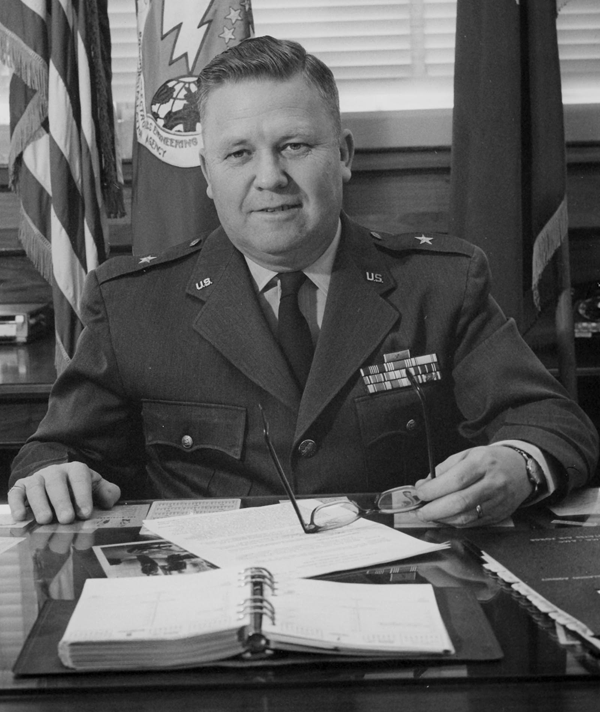
Brigadier General Haskell E. Neal, USAF
(b.1924 - d.1981)
Haskell E. Neal was born in Louisville, Ill., in 1904,and
moved to Hoopeston, Ill., in 1921. He displayed an early
interest in radio communications, completing his first
homemade receiver when he was only 12 years old. His
inclinations led him to enlist in the Army Air Corps at
Scott Field, Ill., March 13, 1928. Almost from the moment of
his enlistment he became involved in the development of
military communications.
As an enlisted man, he attended service schools in both the
Air Corps and the Signal Corps, and also the RCA Resident
School in New York in 1932.
His extensive 14 year background of military experience,
specializing in the growing field of communications,
qualified the then Master Sergeant Neal for elevation to
second lieutenant May 5, 1942. As a commissioned officer he
was first assigned to the 13th Communications Squadron, a
task organization formed at Morrison Field, Fla., to provide
communications support for planned invasion and military
operations in North Africa.
He served as commanding officer of the 13th Communications
Squadron, Africa, and as regional control officer of the
13th Airways Communications Region from May 4, 1942 until
Aug. 31, 1943. Accepting new communications responsibilities
at a pace commensurate with the speed of the whirlwind
African campaign, he was named area control officer for all
of Africa and the Middle East Sept. 1, 1943. He held this
position until Dec. 13, 1944.
His promotions during wartime paralleled the growth of his
responsibilities. He was promoted to first lieutenant May
11, 1942, six days after he was commissioned. He skipped the
grade of captain completely, was promoted to major June 6,
1942, to lieutenant colonel Feb. 25, 1943, and to colonel
Aug. 28, 1944.
After the communications build-up necessary to the North
African campaign was completed, Colonel Neal became
commander of the 3rd AACS Wing at Elmendorf Field, Alaska,
Dec. 14, 1944. He received the additional duty of air
communications officer for Alaska Feb. 4, 1945. In this
capacity, he reported directly to the chief of staff, U.S.
Air Force, who was, at that time, General H.H. ("Hap")
Arnold.

Brigadier General Neal's two dog tags he wore complete
with a St. Christopher medal and the bracelet with name,
rank, blood type and number.
After serving in Headquarters AACS as assistant chief of
staff; operations, training and requirements from May 1945
until August 1947, Colonel Neal was selected to attend the
Air Command and Staff School at Maxwell Field, Ala. Upon
graduation from the Air Command and Staff School, he was
assigned as director of communications and electronics for
the Caribbean Air Command.
Returning to the United States in January 1950, Colonel Neal
entered the Armed Forces Staff College at Norfolk, Va., from
which he graduated in July 1950.
He was named assistant director of communications and
electronics, Continental Air Command in August 1950; and,
when Air Defense Command and Tactical Air Command were
reborn out of the reorganization of CONAC, he was named
director of communications and electronics for the Air
Defense Command.
In this capacity, he was associated with the build-up of Air
Defense Command from an organization embracing only two
fighter wings and less than a score of active AC&W sites to
the modern fighting force charged with responsibility for
the air defense of the North American Continent. As director
of communications and electronics, he was the whip behind
the development of a modern surveillance and detection
system that grew from a jury rigged "lash-up" expedient to
an integrated AC&W system composed of hundreds of permanent
radar stations, including the Pine Tree Line, the seaward
extension of radar by picket ships, Texas Towers, airborne
"early warning" aircraft, and the Distant Early Warning
(DEW) Line.
On July 11, 1955, Colonel Neal was promoted to brigadier
general. Later, in recognition of his outstanding service to
the nation through his assignment with Air Defense Command,
General Neal was awarded the oak leaf cluster to the Legion
of Merit for duty performed between 1951 and 1957. In
addition to his two Legions of Merit, General Neal has also
been awarded the Commendation Ribbon.
From July 8, 1957 to March 9, 1959 General Neal was assigned
as commander, 1807th AACS Wing, Bitburg, Germany. Soon after
his arrival, the 1807th was redesignated as the
European-African Middle Eastern AACS area with its
headquarters transferred to Weisbaden, Germany.
On March 10,1959 General Neal was designated commander of
the newly formed Ground Electronics Engineering-Installation
Agency with Headquarters at Griffiss Air Force Base, N.Y.
Under his direction, GEEIA has grown from a widely separated
heterogeneous group of individuals to a modern, unified
agency charged with the engineering and installation of the
Air Forces entire ground communication systems and
facilities. Under his leadership GEEIA achieved the maturity
of a "can do" organization. This includes an active role in
all phases of ground electronics from the massive,
integrated installation of communications at each Atlas,
Titan and Minuteman missile site, to the down range tracking
facilities of the Atlantic Missile Test Range, the base wire
and telephone development schedules at each Air Force
installation and integral participation on each of the "L"
systems such as Sage and Aircom.
He retired in 1964 as a U.S. Air Force Brigadier General.
Date of Passing: July 15, 1981
Location of Interment: Arlington National Cemetery -
Arlington, Virginia Wall/Plot Coordinates Sec: 59, Site: 589
Source:
https://www.af.mil/About-Us/Biographies/Display/Article/106058/brigadier-general-haskell-e-neal/
|
Ribbon Bar |
|
 |
| Duty Stations/ Advancement
Schools |
|
 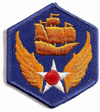 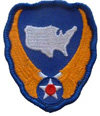  |
1928-1932, United States Army Air Corps (USAAC)
1948-1950, Caribbean Air Command
1950-1957, Continental Air Command (CAC)
1959-1964, Ground Electronics Engineering
Installation Agency (GEEIA)
|
| Combat and Non-Combat
Operations |
1942-1944 World War
II/European-African-Middle Eastern Theater/Air
Offensive, Europe Campaign (1942-44)
|
| 1942-1944 |
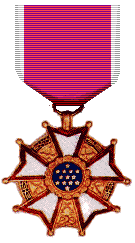 |
War Department
General Staff (Legion of Merit) SYNOPSIS:
Colonel (Air Corps) Haskell E. Neal, United States
Army Air Forces, was awarded the Legion of Merit for
exceptionally meritorious conduct in the performance
of outstanding services to the Government of the
United States during World War II. The singularly
distinctive accomplishments of Colonel Neal and his
dedicated contributions in the service of his
country reflect the highest credit upon himself and
the United States Army Air Forces.
SYNOPSIS: Brigadier General Haskell E. Neal,
United States Air Force, was awarded a Bronze Oak
Leaf Cluster in lieu of a Second Award of the Legion
of Merit for exceptionally meritorious conduct in
the performance of outstanding services to the
Government of the United States as Director of
Communications, Continental Air command, from 1951
to 1957. The singularly distinctive accomplishments
of General Neal and his dedicated contributions in
the service of his country reflect the highest
credit upon himself and the United States Air Force. |
| Colleges Attended |
|
  |
1948-1949, Air Command and Staff College
1950-1951, Armed Forces Staff College
|
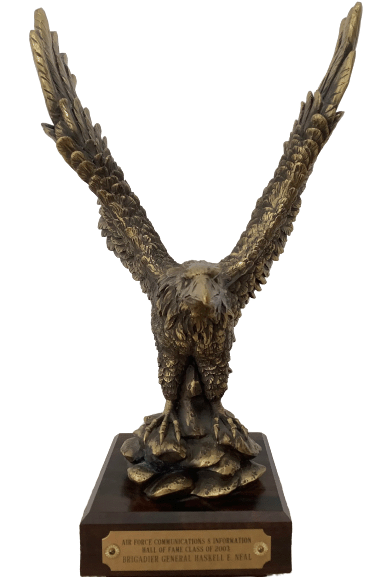
Air Force Communications & Information Hall of Fame Class
of 2003 Award - Brigadier General Neal received this
award posthumously in 2003. He was one of the first
inductees into the USAF Communications and Information Hall
of Fame in 2003. The award was received by his widow,
Elizabeth M. Neal, on his behalf at a gala in Washington,
DC. Four other general officers received the same accolade.
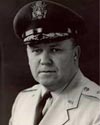 Brig.
Gen. Haskell E. Neal Brig.
Gen. Haskell E. Neal
Serving from March 1928 to June 1964, Neal was first an
enlisted communicator in the Army Air Corps/Army Air Forces.
He received a direct commission during the early days of
World War II. From 1951 to 1957, he was associated with the
buildup of the newly-created Air Defense Command into a
modern fighting force charged with responsibility for the
air defense of the North American continent. As director of
communications and electronics, he was responsible for
development and implementation of U.S. and Canada's warning
and surveillance networks, a modern surveillance and
detection system that grew to an integrated system Distant
Early Warning, or DEW line with hundreds of permanent radar
stations. He was also the first Ground Electronics
Engineering Installation Agency, or GEEIA, commander. He
established an organizational structure that GEEIA followed
throughout its existence (1958-1970). GEEIA was charged with
the engineering and installation of the Air Force's entire
worldwide ground communication systems and facilities. Neal
died in 1981.
Source:
https://www.afnic.af.mil/About-Us/Fact-Sheets/Display/Article/401702/hall-of-fame-class-of-2003/
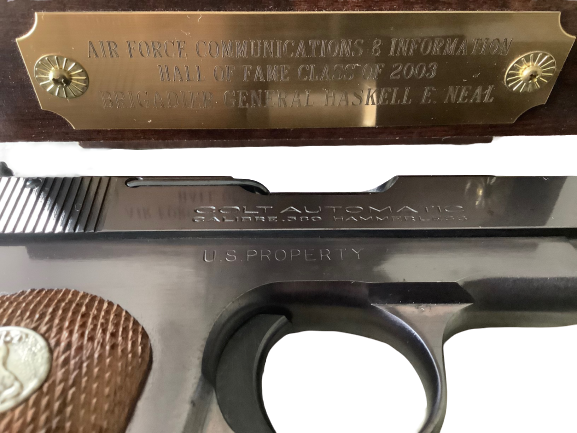
After retirement from the Air Force, General Neal took his considerable expertise to the private sector working for General Electric in a senior managerial position for a number of years.
Final retirement was in Summerville, South Carolina outside of Charleston where he and his wife, Lib, spent their time relaxing and playing host to their two children their spouses and their families where to his six grand children he was just plain “Granddad”.
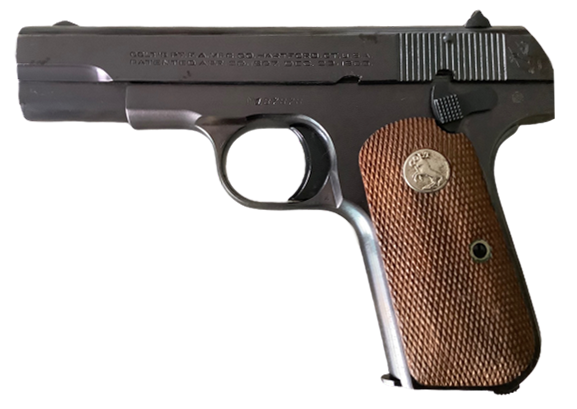
Colt Model 1908 Pocket Hammerless .380 ACP serial number
M137878
issued to Brigadier General Haskell E. Neal - left side |